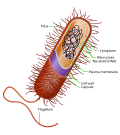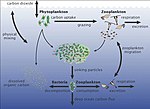Thiomargarita namibiensis is a harmless, gram-negative, facultative anaerobic, coccoid bacterium found in the ocean sediments of the continental shelf...
33 KB (3,785 words) - 07:38, 28 May 2024
Thiomargarita is a genus (family Thiotrichaceae) which includes the vacuolate sulfur bacteria species Thiomargarita namibiensis, Candidatus Thiomargarita...
5 KB (410 words) - 20:06, 21 February 2024
size of these organisms. Cells of the large sulfur bacterium Thiomargarita namibiensis, discovered in 1999, contain a large sac (vacuole) filled with...
7 KB (738 words) - 04:58, 30 April 2024
The Thiotrichaceae are a family of Pseudomonadota, including Thiomargarita namibiensis, the largest known bacterium. Some species are movable by gliding...
1 KB (61 words) - 17:22, 3 May 2022
can vary in size from 0.2 μm (Mycoplasma genitalium) to 750 μm (Thiomargarita namibiensis). Prokaryotic cells have various shapes; the four basic shapes...
44 KB (4,770 words) - 01:02, 19 May 2024
are microscopic, with a few extremely rare exceptions, such as Thiomargarita namibiensis. Bacteria function and reproduce as individual cells, but they...
73 KB (7,743 words) - 20:08, 6 June 2024
eye—for example, Thiomargarita namibiensis is up to half a millimetre long, Epulopiscium fishelsoni reaches 0.7 mm, and Thiomargarita magnifica can reach...
143 KB (15,517 words) - 01:42, 1 June 2024
plastid. This is known as secondary endosymbiosis. The marine Thiomargarita namibiensis, the largest known bacterium Cyanobacteria blooms can contain...
304 KB (29,027 words) - 03:21, 16 May 2024
The Thiotrichales are an order of Pseudomonadota, including Thiomargarita magnifica, the largest known bacterium. They also include certain pathogens...
1 KB (57 words) - 10:48, 30 June 2022
from 0.2 - 0.7 mm (200–700 μm) in length. Until the discovery of Thiomargarita namibiensis in 1999, Epulonipiscium species were thought to be the largest...
11 KB (1,094 words) - 19:31, 20 January 2024
in the cycling of silicon in the ocean. One anaerobic species, Thiomargarita namibiensis, plays an important part in the breakdown of hydrogen sulfide...
51 KB (6,146 words) - 16:27, 7 June 2024
sanctuary) in Wellington, New Zealand, completed. The bacterium Thiomargarita namibiensis is discovered off the coast of Namibia. At 0.3mm in diameter,...
9 KB (1,011 words) - 13:33, 25 February 2024
plastid. This is known as secondary endosymbiosis. The marine Thiomargarita namibiensis, largest known bacterium Cyanobacteria blooms can contain lethal...
232 KB (21,388 words) - 09:31, 2 June 2024
community are Roseobacter. The largest known bacterium, the marine Thiomargarita namibiensis, can be visible to the naked eye and sometimes attains 0.75 mm...
140 KB (12,895 words) - 20:27, 14 June 2024
of the central area of a human cornea 750 μm – diameter of a Thiomargarita namibiensis, the largest bacteria known 760 μm – thickness of an identification...
173 KB (16,319 words) - 10:32, 16 June 2024
"Uptake Rates of Oxygen and Sulfide Measured with Individual Thiomargarita namibiensis Cells by Using Microelectrodes". Applied and Environmental Microbiology...
33 KB (3,816 words) - 07:41, 19 May 2024










